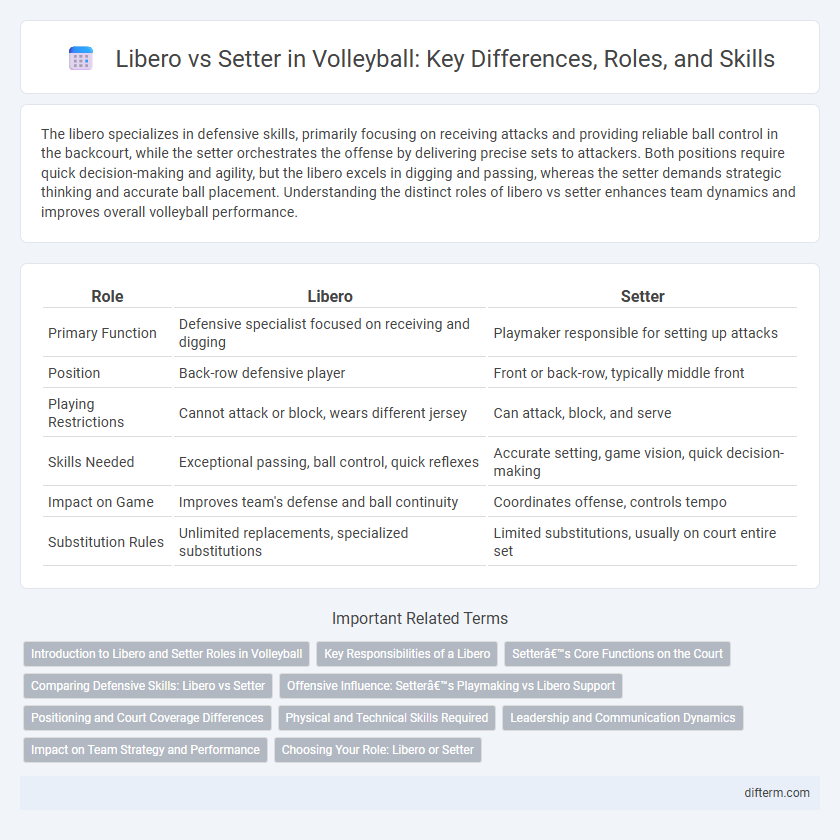The libero specializes in defensive skills, primarily focusing on receiving attacks and providing reliable ball control in the backcourt, while the setter orchestrates the offense by delivering precise sets to attackers. Both positions require quick decision-making and agility, but the libero excels in digging and passing, whereas the setter demands strategic thinking and accurate ball placement. Understanding the distinct roles of libero vs setter enhances team dynamics and improves overall volleyball performance.
Table of Comparison
| Role | Libero | Setter |
|---|---|---|
| Primary Function | Defensive specialist focused on receiving and digging | Playmaker responsible for setting up attacks |
| Position | Back-row defensive player | Front or back-row, typically middle front |
| Playing Restrictions | Cannot attack or block, wears different jersey | Can attack, block, and serve |
| Skills Needed | Exceptional passing, ball control, quick reflexes | Accurate setting, game vision, quick decision-making |
| Impact on Game | Improves team's defense and ball continuity | Coordinates offense, controls tempo |
| Substitution Rules | Unlimited replacements, specialized substitutions | Limited substitutions, usually on court entire set |
Introduction to Libero and Setter Roles in Volleyball
The libero specializes in defensive skills, primarily responsible for receiving serves and digging attacks, wearing a distinct jersey for easy identification and limited to back-row play. The setter functions as the team's playmaker, orchestrating offensive strategies by delivering accurate sets to hitters and often acting as the second attacker. Both roles are crucial for a volleyball team's success, emphasizing defensive stability and offensive coordination.
Key Responsibilities of a Libero
A libero in volleyball specializes in defensive skills, primarily responsible for receiving serves, digging attacks, and maintaining ball control in the back row. Unlike the setter, who orchestrates offensive plays by delivering precise sets to attackers, the libero ensures the team's defense remains strong and transitions smoothly into counterattacks. This role demands exceptional reflexes, agility, and communication to enhance the team's overall defensive stability.
Setter’s Core Functions on the Court
The setter orchestrates the team's offense by delivering precise, strategic sets that enable attackers to execute powerful spikes. Mastery in ball placement and quick decision-making distinguishes the setter's role as the primary playmaker. Unlike the libero, whose focus is defense and ball control, the setter's core functions center on facilitating scoring opportunities and maintaining offensive flow.
Comparing Defensive Skills: Libero vs Setter
The libero specializes in defensive skills such as exceptional digging, quick reflexes, and consistent passing, primarily anchoring the backcourt defense with superior ball control. The setter, while primarily responsible for orchestrating offensive plays, also contributes defensively by reading opponents' attacks and performing strategic digs and blocks when necessary. Comparing both, the libero maintains a higher focus on defensive agility and anticipation, whereas the setter balances defensive responsibilities with dynamic offensive decision-making.
Offensive Influence: Setter’s Playmaking vs Libero Support
The setter drives offensive strategies by orchestrating precise ball distribution to attackers, maximizing scoring opportunities through tactical playmaking. The libero enhances offensive efficiency by maintaining ball control, executing accurate passes, and enabling quick transitions from defense to attack. While the setter directly influences offensive setups, the libero's support ensures consistent possession and fluid ball movement essential for successful offensive execution.
Positioning and Court Coverage Differences
Liberos specialize in defense with exceptional court coverage focused on the back row, excelling in digging and passing to enhance team stability. Setters position themselves near the net, orchestrating plays by delivering precise sets to attackers and maintaining offensive flow. While liberos prioritize lateral and deep court coverage, setters optimize positioning near the net for quick decision-making and ball distribution.
Physical and Technical Skills Required
The libero requires exceptional agility, quick reflexes, and advanced defensive skills to excel in ball control, digs, and serve receive, making speed and anticipation critical physical and technical attributes. In contrast, the setter demands precise hand positioning, strong decision-making abilities, and excellent spatial awareness to execute accurate sets and control offensive plays, emphasizing upper body coordination and strategic thinking. Both roles rely heavily on stamina and court awareness, but the libero focuses more on defensive mastery while the setter prioritizes offensive orchestration.
Leadership and Communication Dynamics
The libero excels in defensive leadership by organizing the backcourt and signaling positional adjustments, fostering seamless team coordination. Setters command offensive communication, directing play patterns and orchestrating attacks through precise ball distribution and on-court decision-making. Both roles require acute awareness and vocal presence, but the setter's leadership typically shapes overall team tempo while the libero anchors defensive stability.
Impact on Team Strategy and Performance
The libero anchors the team's defense by specializing in receive and digging, which enhances ball control and sustains counter-attack opportunities. The setter orchestrates offensive strategy by delivering precise sets that maximize hitters' scoring chances and dictate game tempo. Their coordinated roles optimize team performance through balanced defense and dynamic offense execution.
Choosing Your Role: Libero or Setter
Choosing your role in volleyball depends on your skills and game vision; the libero specializes in defensive skills with quick reflexes and precise ball control, focusing on serve receive and digs, while the setter acts as the team's playmaker, emphasizing strategic decision-making and accurate ball distribution to attackers. Libero players excel in agility and anticipation, constantly reading the opponent's offense to provide reliable passing, whereas setters require strong communication skills and spatial awareness to orchestrate offensive plays and set up spikes. Assessing your strengths in defense versus playmaking helps determine whether the libero's defensive mastery or the setter's leadership role best suits your contribution to the team.
libero vs setter Infographic

 difterm.com
difterm.com